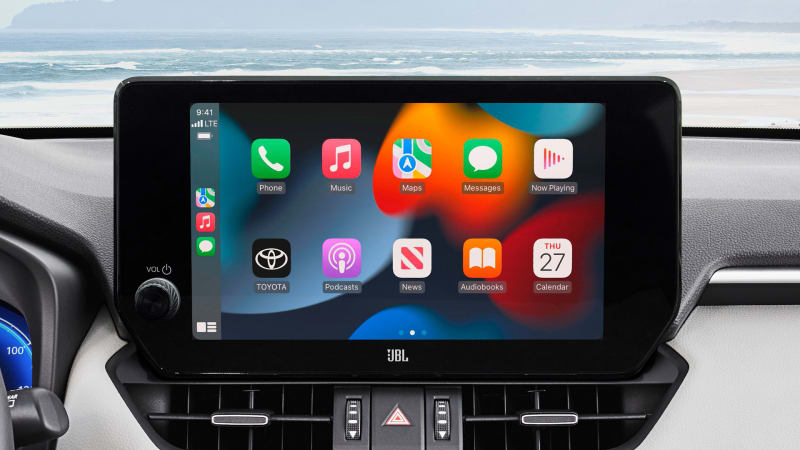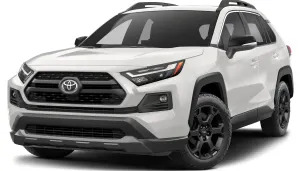2024 Toyota RAV4 Review
Pros: Something-for-everyone variants; strong fuel economy; available plug-in hybrid; reliability and resale value
Cons: Unrefined powertrains; tech interface can frustrate; less luxurious than rivals
It may seem hard to believe, but 2019 was a long time ago. Or wait, does it feel like it was 100 years ago? Either way, the 2024 Toyota RAV4 represents the sixth model year since the best-selling compact SUV was totally redesigned. It was a thoroughly impressive redesign, which injected character and capability into what had been a rather dull product, but as they say, time moves on. Importantly, so does the competition, and the RAV4 is now one of the segment’s elder statesmen. The Kia Sportage, Hyundai Tucson, Nissan Rogue, and most notably, Honda CR-V have all been redesigned in recent years and in many ways are stronger than the RAV4 as a result.
All of that said, we still recommend the 2024 RAV4 due to its unmatched variety of trim levels, exceptional fuel economy and long-term ownership prospects. Quite simply, it’ll still make sense for a lot of buyers. The hybrids in particular, including the Prime plug-in hybrid, are our top choices given their superior fuel economy and performance. Plus, with the introduction of the Woodland Edition last year, there is now a hybrid answer to the more rugged, gas-only Adventure and TRD Off-Road trims. Should you be more into a sportier vibe, the SE and XSE remain exclusive to Hybrid are the best RAV4s to drive on-road. Really, there’s something for everyone, along with a solid backbone of well-rounded practicality.
So, how has it fallen behind, then? Well, the gas-only and hybrid powertrains are louder and less refined. Toyota’s infotainment system is a tolerate-or-hate-it proposition. The cabin design isn’t as premium in appearance or materials as many rivals. There are then plenty of smaller things that one competitor or another just does a bit better. Basically, nothing deal-breaking per se, but it makes for a tougher choice between the RAV4 and those newer, very impressive rivals.
Interior & Technology | Passenger & Cargo Space | Performance & Fuel Economy
What it's like to drive | Pricing & Trim Levels | Crash Ratings & Safety Features


What's new for 2024?
Last year’s new Woodland Edition gets the most attention this year with the addition of a new two-tone paint option, a 1¼-inch “activity mount” pictured above (it’s a trailer hitch you can plug bike racks into rather than a trailer), and a new Weather package that adds heated front seats and a leather-wrapped steering wheel. The Woodland, Adventure and TRD Off-Road are also now available in Army Green, which dates back to the FJ Cruiser as a Toyota SUV favorite. It is pictured above and just looks sensational with the Woodland's bronze wheels.

What are the RAV4 interior and in-car technology like?
Interior materials are acceptably average for the RAV4's compact crossover class, and much better than past generations. Materials and build quality are excellent. That said, the RAV4 never achieves the near-luxury vibe of its rivals’ top trim levels. Genuine leather is not available, and the SofTex vinyl that comes on up-level models isn't a convincing substitute. This could certainly be a problem on pricier trim levels, especially the Prime that can approach $50,000 with options. Nevertheless, we like the use of colorful trim pieces that differentiate the various models. And if you are going for a more premium vibe, the Toyota Venza is basically just a fancier RAV4 Hybrid. And the new Lexus NX is a fancier step beyond that.
In-car storage is better than most with large and versatile cupholders, an easily accessed spot to store and charge your phone, an under-armrest bin and unique shelves built into the dash. In the cargo area, the floor is double sided (one carpet, one easy-to-clean plastic) and the cargo cover can be hidden away below it. Neither is included with the RAV4 Prime, but we do like that it provides a spot for the cumbersome portable charge cord: It cleverly can be wrapped around a foam doughnut within the spare tire. Usually a plug-in vehicle resorts to a small briefcase-like bag that takes up cargo space.
An all-digital instrument panel is found on top trim levels and is basically expected now in the segment. It’s fine. The touchscreen interface, which was new last year, is also just fine. The good news is that it looks far more modern than the RAV4’s old interface, has more state-of-the-art features, and reacts far quicker to user inputs. The screens are also bigger, with the base touchscreen growing to 8 inches (below left) and the top-of-the-line growing to 10.5 (below right). The bad news is that they’re no longer accompanied by the handy physical menu buttons that made the outgoing system so user-friendly (the radio controls were also far better). Going in between Toyota’s controls and the Apple CarPlay/Android Auto interfaces are particularly annoying without the old home button or at least menu buttons permanently docked on the screen. How you feel about any of this will largely depend on how you use a car’s tech interface, but either way, we think the systems of most rivals remain superior.


How big is the RAV4?
The RAV4 isn’t class-leading when it comes to passenger or cargo space, but we’re really talking about degrees of “really big and practical” when sizing up the merits of the RAV4 versus the Kia Sportage and Hyundai Tucson. The important thing is that it remains one of the most practical small SUVs. Full-sized adults and rear-facing child seats will have no problem fitting, and if you’re seeking family-friendly transportation, it’s hard to imagine being disappointed by the RAV4’s passenger space.
It's a similar situation with cargo space. The specs say it has 69.8 cubic-feet of maximum cargo space and 37.5 cubic-feet with the back seat raised. That’s bigger and better than most compact crossovers (including the Honda CR-V), but ultimately less than the Kia Sportage and Hyundai Tucson. Our cargo testing showed the RAV4 does indeed fall into that third-place zone when it comes to carrying actual stuff. We would be quick to note, however, that the RAV4 Hybrid includes a spare tire, whereas the Tucson Hybrid and CR-V hybrid models do not (the Sportage does). Now, the RAV4 Prime plug-in hybrid does lose its spare tire and some cargo space as well since its floor is higher, but we doubt you’d notice the resulting difference.
We would also be remiss if we didn't mention the RAV4's ample ground clearance, especially in the Adventure and TRD Off-Road trim levels, which contributes to it being one of the more capable compact SUVs off the beaten path. Only the Subaru Forester, and especially its Wilderness model, and Jeep Cherokee Trailhawk have greater clearance than the off-road-oriented RAV4s. Even the lowest RAV4 — the XSE Hybrid — still clears 8 inches, which is better than most.


What are the RAV4 fuel economy and performance specs?
The standard RAV4 powertrain is a 2.5-liter four-cylinder good for 203 horsepower and 184 pound-feet of torque. That's above average for the segment, but acceleration doesn't wow, with a run from 0-60 mph taking an estimated 8.1 seconds.
An eight-speed automatic transmission and front-wheel drive are standard, while two all-wheel-drive systems are optional depending on trim level. The first is a basic reactive system that sends power to the rear wheels in the event of slippage, whereas the second available on the Adventure, TRD Off-Road and Limited trim levels more actively sends power around, including between the rear wheels to improve wet weather traction as well as dry road handling. It also includes off-road vehicle settings for "Mud & Sand," "Rock & Dirt" and "Snow."
Fuel economy estimates for 2024 were not available at the time of this writing, but it’s doubtful they’d changed substantially from the 2023 estimates listed here. With front-wheel drive, the RAV4 returns 27 mpg city, 35 mpg highway and 30 mpg combined. Opting for one of the all-wheel-drive systems knocks down the highway and combined numbers by 1 or 2 mpg. No big deal, really. That includes the TRD Pro and its all-terrain tires – we even managed 31.3 mpg during a 700-mile road trip in the TRD Off-Road.
The RAV4 Hybrid gets a different 2.5-liter engine along with three electric motors that combine to offer up 219 horsepower. The electric motor at the rear effectively gives the Hybrid standard all-wheel drive. Its 0-60 estimate is 7.8 seconds, meaning the Hybrid is not only a more fuel-efficient choice, but a higher performance one too (albeit barely). Fuel economy stands at 41 mpg city, 38 mpg highway and 40 mpg combined for all trim levels but the Woodland, which gets knocked down to a still-exceptional 38/35/37 due to its all-terrain tires.
Finally, there's the RAV4 Prime plug-in hybrid that has more powerful motors and a higher capacity battery pack. When fully charged, it yields 302 total system horsepower, a 0-60 time of 5.8 seconds and an EPA-estimated range of 42 miles (more than most other PHEVs). Should you exhaust the all-electric range, it basically operates like the regular hybrid and returns similar fuel economy. So, the more you use its all-electric range, the more efficient it is.


RAV4 TRD Off-Road and RAV4 Prime
What's the RAV4 like to drive?
The RAV4 isn't the boring, anonymous crossover it once was. It may not engage like a Mazda CX-50, but there is still an eagerness to its turn-in and a commendable poise through corners without sacrificing ride quality. The handling capability and steering feel of the various models also isn't vast, though the sport-tuned SE/XSE Hybrid (pictured above) and Prime models are certainly more adept at tackling a winding mountain road. Even the TRD Off-Road and new Woodland Edition are capable handlers, although their all-terrain tires do result in firmer reactions to bumps and a bit more road noise.
Really, the biggest difference comes down to powertrain choice. The base four-cylinder looks good on paper, but in practice, it's merely acceptable for the segment and we found it a bit loud and buzzy. The Hybrid actually improves this, as it adds that initial kick of electric power to smooth things out. Still, prolonged acceleration reveals the typical Toyota hybrid drone that you just don’t get in the Hyundai/Kia or Honda systems. Ultimately, both of these engines are about providing good fuel economy without a penalty for drivability (there's no throttle lag or unusual transmission programming, for instance). They succeed, but if you want more refinement or guts, you'll have to look elsewhere.
Now, "elsewhere" could very well be the RAV4 Prime. It has 302 horsepower when the battery is fully charged and its acceleration is a strong and inspiring as its 0-60 time of 5.8 seconds would indicate. It genuinely feels like an electric car. However, that changes when that all-electric range is exhausted. Acceleration goes from inspiring to unremarkable. So, whether you're talking performance or fuel economy, it's best to keep the Prime charged.
What other Toyota RAV4 reviews can I read?
2021 Toyota RAV4 Prime First Drive
Our specific review of the Prime shows that a plug-in hybrid powertrain makes for a better RAV4, but a RAV4 also makes for a better plug-in hybrid. It has a different tech interface and instrument panel now, but our impressions remain broadly the same.

2020 Toyota RAV4 TRD Off-Road Review
We drive (and sail!) the most off-roady version of the RAV4 on a 700-mile road trip to western Canada. Though it looks slightly different now and has a different tech interface, our overall conclusions remain the same.

2020 Toyota RAV4 Interior Review
We dive deep into the RAV4's interior storage, quality and technology. As the technology has now been replaced, feel free to skip those bits.

Car seat comparison test: Toyota RAV4 vs Mazda CX-5 vs Subaru Forester vs (last-gen) Honda CR-V
A deep dive comparison of the space and ease of installation provided by the RAV4 and three key rivals for child seats.
2019 Toyota RAV4 First Drive Review | Definitely not playing it safe
A comprehensive look at all the changes undergone for the current RAV4 generation, including details about its design and engineering.

2019 Toyota RAV4 Adventure Drivers' Notes Review | More character, more capability
Our review of the off-road-oriented Adventure trim level, which boasts additional ground clearance and chunky good looks that we prefer over the standard version.

2019 Toyota RAV4 Hybrid Drivers' Notes Review | A wallflower no more
Our Quick Spin review of the RAV4 Hybrid, which we found is very nice to drive despite its intended role as the fuel-sipping option.

What is the 2024 Toyota RAV4 price and where is it made?
The RAV4 offers buyers the most diverse array of choices in the compact SUV segment. Rather than just a traditional trim level structure where each trim level has more feature content, the RAV4 provides different looks and skill sets. Specifically, anything with “SE” in the name has a sport-tuned suspension and steering, and has racier looks with lots of cool black trim. The Adventure, Woodland and TRD Pro are more rugged and intended for outdoor adventures. Anything with “LE” is more of a traditional choice in terms of look and suspension/steering tune, while the Limited is the most luxurious a RAV4 can get (though it’s admittedly less luxurious than the comparable trims of rivals).
You can find a breakdown of each trim level’s features, specs and local pricing here at Autoblog for the gas-only RAV4, here for the RAV4 Hybrid and here for the RAV4 Prime. Yes, it’s annoying that we don’t put them all on the same page. Sorry.
All prices below include the $1,335 destination charge. The RAV4 Prime may also be eligible for state-level rebates or tax credits.
Gas-only RAV4
LE: $29,825
XLE: $31,335
XLE Premium: $34,225
Limited: $38,130
Adventure (AWD only): $36,020
TRD Off-Road (AWD only): $39,445
All-wheel drive is a $1,400 option on all gas-only RAV4s but the Adventure and TRD Off-Road, which included it as standard. All-wheel drive is standard on all hybrids, which are listed below.
RAV4 Hybrid
LE: $32,825
XLE: $34,335
XLE Premium: $37,225
SE: $35,520
Woodland: $36,045
XSE: $38,485
Limited: $41,130
Pricing for the Prime was not available at the time of this writing.
Where the RAV4 is built depends on what powers it. The gas-only RAV4 is built in Woodstock, Ontario; the RAV4 Hybrid is built in Georgetown, Ky.; the RAV4 Prime is built in Nagasuka, Japan.
What are the RAV4 safety ratings and driver assistance features?
Every RAV4 comes standard with forward collision warning and automatic emergency braking with pedestrian and cyclist detection, emergency steering assist, lane-departure warning and lane-keeping assist, automatic high beams, and adaptive cruise control. Blind-spot and rear cross-traffic warning systems are optional on the LE trim level and standard on all others. A rear cross-traffic automatic braking system is standard on the Limited and optional on all trims but the LE.
The National Highway Traffic Safety Administration gave the RAV4 five out of five stars for overall and side crash protection, and four stars for frontal. The Insurance Institute for Highway Safety named the RAV4 a Top Safety Pick for its "Good" ratings in all crash tests but the two newest, more stringent IIHS crash test where it got a second-best "Acceptable." Its “Good” headlight rating and top marks for its collision prevention tech rounded out its credentials for the award.
Autoblog accepts vehicle loans from auto manufacturers with a tank of gas and sometimes insurance for the purpose of evaluation and editorial content. Like most of the auto news industry, we also sometimes accept travel, lodging and event access for vehicle drive and news coverage opportunities. Our opinions and criticism remain our own – we do not accept sponsored editorial.


























































